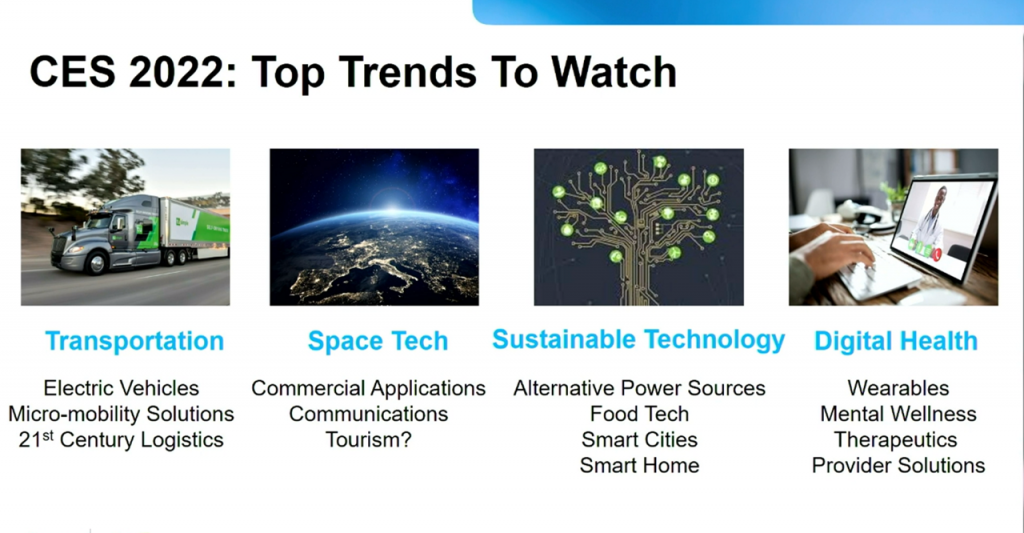 The four top trends to watch for this week at CES 2022 are transportation, space tech, sustainable technology, and digital health, based on Steve Koenig’s annual read-out that kicks off this largest annual conference featuring innovations in consumer electronics.
The four top trends to watch for this week at CES 2022 are transportation, space tech, sustainable technology, and digital health, based on Steve Koenig’s annual read-out that kicks off this largest annual conference featuring innovations in consumer electronics.
Last night, Steve discussed these trends for media attendees, of which I am one (gratefully) participating in #CES2022 virtually from the hygienic comfort and safety of my home health hub (more on that later in this post).
All four of these mega-themes impact health and well-being in some way. “Space Tech?” you might wonder. Yes. My friend Dorit Donoviel can be an Exhibit A for that, with her pioneering work leading space-health research at the Baylor College of Medicine.
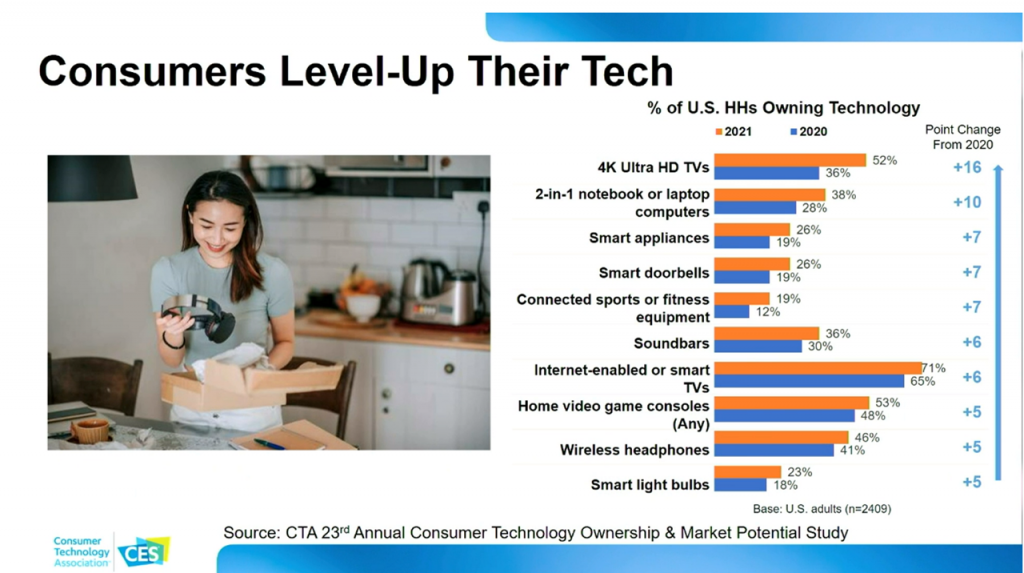 Before I dive into the details of digital health in CTA’s tech trend consumer survey, I’ll share some of Steve’s top-line insights that provide important context for the evolving home as health hub.
Before I dive into the details of digital health in CTA’s tech trend consumer survey, I’ll share some of Steve’s top-line insights that provide important context for the evolving home as health hub.
The bar chart illustrates “consumers leveling up their tech” as more people are investing in technology to “lead a 21st century lifestyle” in Steve’s words.
Here, note the growth of connected TVs, more spending on laptops and computers (driven heavily by continued working-from-home and educating supported in homes), gaming (again, with homes even more focusing on entertainment and family and individual fun time), and wireless headphones — part of that 21st century living.
See that connected sports and fitness equipment grew by 7 percentage points in U.S. households owning this form of technology.
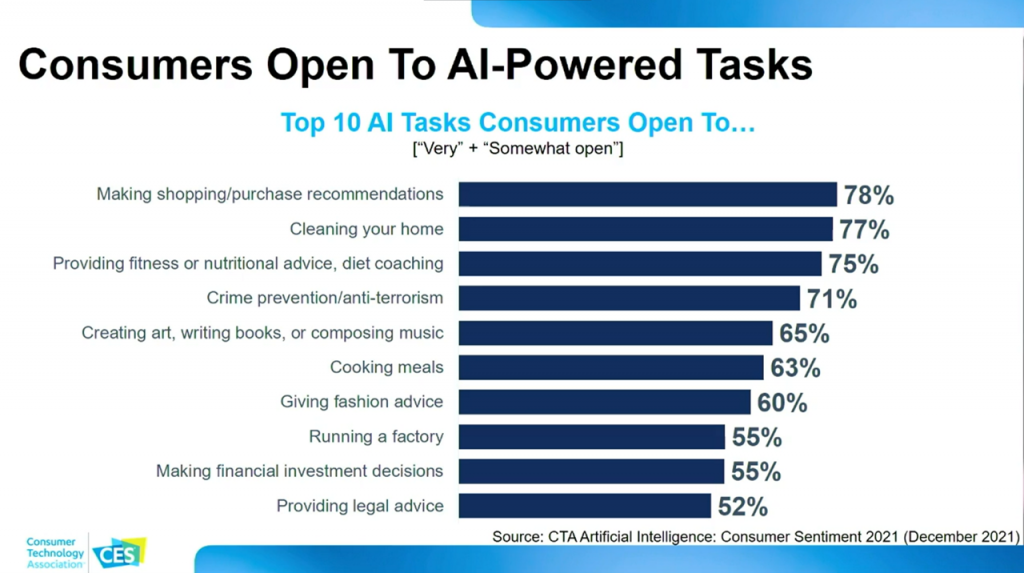 Another important data point in this consumer-tech environmental analysis is that more people are open to artificial intelligence baked into the tasks of daily living, shown in the third chart. Among the top 10 AI-informed tasks to which people would be open are shopping and purchase recommendations, fitness or nutritional advice, and cooking meals — all life-flows that can feed into a healthy lifestyle or medically-tailored support at home.
Another important data point in this consumer-tech environmental analysis is that more people are open to artificial intelligence baked into the tasks of daily living, shown in the third chart. Among the top 10 AI-informed tasks to which people would be open are shopping and purchase recommendations, fitness or nutritional advice, and cooking meals — all life-flows that can feed into a healthy lifestyle or medically-tailored support at home.
That AI-powered counsel can emanate from the digital health technologies, apps, and algorithms that people are increasingly using — choosing to do so on their own, as well as adopting new tools based on health care provider and wellness coach recommendations (or “prescriptions”).
Looking back to the first chart above under the digital health category, we see wearables, mental wellness, digital therapeutics, and provider solutions. Together these, and other innovations, can empower consumers for self-care at home and on-the-go.
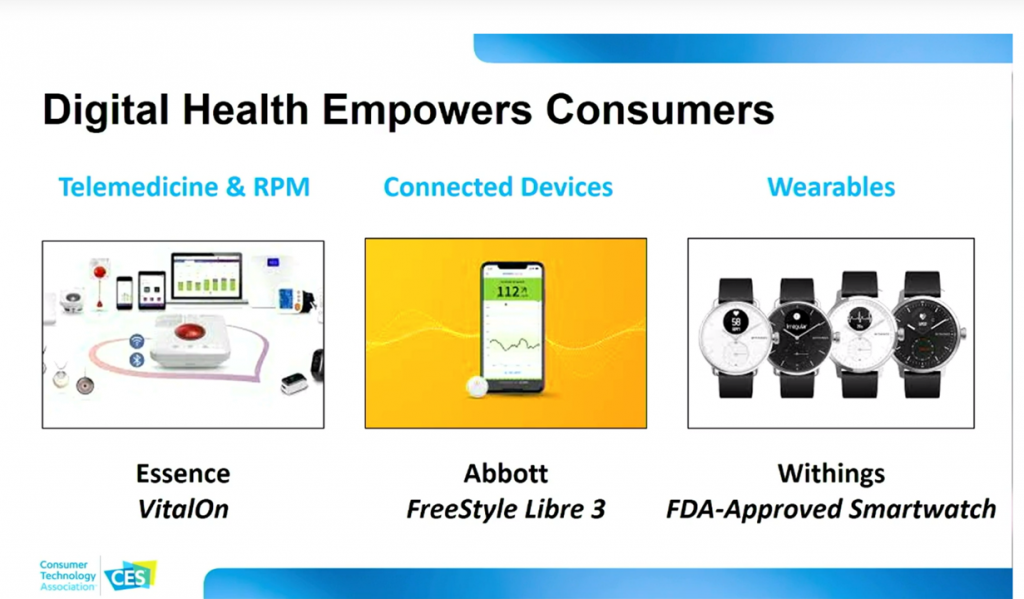 As examples of this, Steve pointed to three CES attendees’ products that speak to self-care empowerment:
As examples of this, Steve pointed to three CES attendees’ products that speak to self-care empowerment:
- For telehealth and remote patient management (RPM), Essence’s VitalOn
- As a connected health device, Abbott’s FreeStyle Libre 3, and
- Withings’ FDA-cleared smartwatch as a health/care wearable technology.
To understand the powerful scenario here, consider these three tools adopted by a person managing diabetes. That patient must attend to many clinical and lifestyle workflows through one 24-hour day — for example, measuring blood glucose levels, tracking blood pressure and activity/exercise, and communicating with a nurse practitioner, health coach, or doctor’s office as well as receiving advice or support from clinical team members.
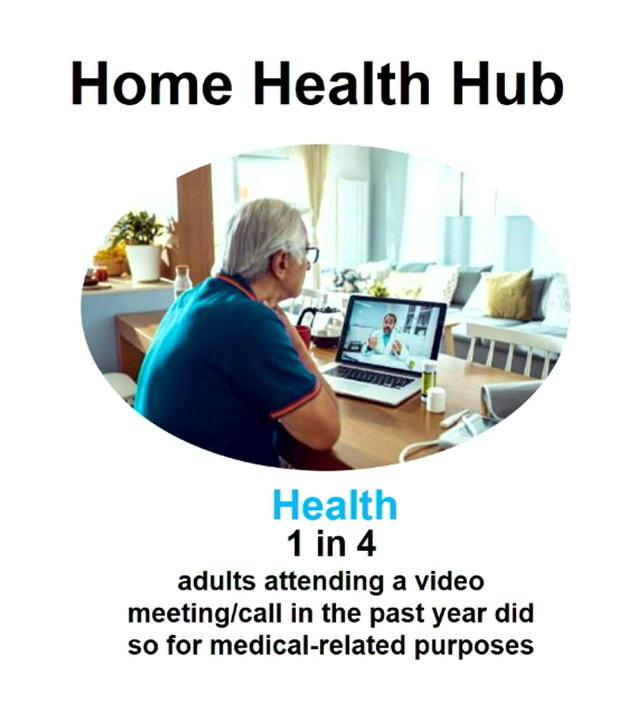
Health Populi’s Hot Points: Our homes are undergoing “the great home makeover,” Steve described. Some of the components underpinning that makeover include enhanced home theatres (think: traditional devices like monitors re-purposed from TVs to home office or other use), smarter homes (for energy efficiency and health home objectives), and pursuing premium (again, that “leveling up” technology and optimizing for a new normal).
Another important trend that is an umbrella over more granular forecasts is the consumer’s embrace of services. To illustrate this, note that consumer-subscribers of subscription-video-on-demand (SVOD) grew by millions in 2021, with Netflix, Amazon Prime Video, Disney+, and AppleTV all expanding their membership rosters. On average, consumers globally subscribe to eight online services. That’s on average.
Now, consider how services on demand fit into health and medical care….such as Peloton and Hydro, the connected fitness companies. Connected wellness and lifestyle services also grew in subscriber bases in 2021 in the U.S. and Europe, CTA’s data shows, with two-thirds of consumers in the U.S. planning to continue using these services (like Peloton or Hydro as examples). Food delivery, too, will see about 60% of U.S. consumers planning to stick with home delivered meal prep packages in 2022.
This last graphic here from Steve’s presentation shows a stunning data point: that in the past year, one in four U.S. adults that attended a video meeting did so for medical-related purposes — such as virtual health care, telemedicine, remote monitoring consultation.
Welcome to #CES2022: where health/care is everywhere. And just as healthcare and medical visits are morphing to omnichannel and digital front doors, so, too, is our collective experience at CES this year. As Steve observed several times in his tech trends discussion last night, “technology is re-shaping our behavior.”
And that technology, both those specifically designed for digital health tools as well as platform tech innovations to support smarter and more hygienic homes, will have the potential to enable greater access and health equity to health citizens the world over (which CTA recently discussed in this important research). That is, if we are mindful and attentive to those objectives for our fellow health citizens….stay tuned here on Health Populi for more CES 2022 health/care observations throughout the week….and if you see some exciting health-related or -adjacent developments in your own CES journeys, please let me know on Twitter @HealthyThinker….


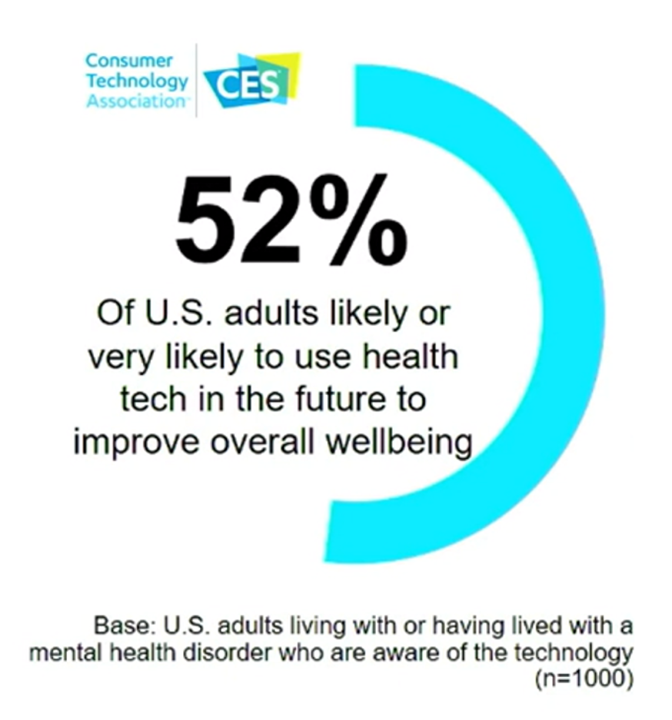


 I'm in amazing company here with other #digitalhealth innovators, thinkers and doers. Thank you to Cristian Cortez Fernandez and Zallud for this recognition; I'm grateful.
I'm in amazing company here with other #digitalhealth innovators, thinkers and doers. Thank you to Cristian Cortez Fernandez and Zallud for this recognition; I'm grateful. Jane was named as a member of the AHIP 2024 Advisory Board, joining some valued colleagues to prepare for the challenges and opportunities facing health plans, systems, and other industry stakeholders.
Jane was named as a member of the AHIP 2024 Advisory Board, joining some valued colleagues to prepare for the challenges and opportunities facing health plans, systems, and other industry stakeholders.  Join Jane at AHIP's annual meeting in Las Vegas: I'll be speaking, moderating a panel, and providing thought leadership on health consumers and bolstering equity, empowerment, and self-care.
Join Jane at AHIP's annual meeting in Las Vegas: I'll be speaking, moderating a panel, and providing thought leadership on health consumers and bolstering equity, empowerment, and self-care.